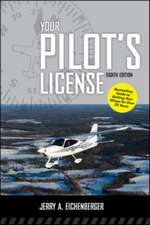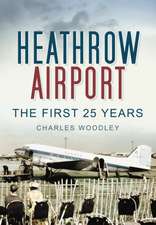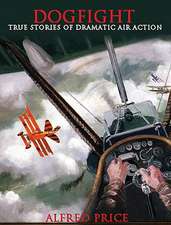Chicago Aviation: An Illustrated History
Autor David M. Youngen Limba Engleză Hardback – 24 apr 2003
From the dawn of flight, Chicago has played a vital role in the development of aviation. Favored by geography and a superb network of railroads, the Windy City rapidly became the nation's crossroad. Young's richly illustrated history portrays the inventors, entrepreneurs, and aviators who conquered the skies and made Chicago the nation's premier hub for air travel and transport.
Aviation's colorful figures come to life as Young recounts tales of the pilots, patrons, and passengers who sparked public interest in the early days of flight. Beginning with Chicago's first aviation event—a balloon ascension on July 4, 1855—Young traces the local personalities and technologies that helped make the dream of flight a reality. He offers the most complete account to date of pioneer Chicago aviator Octave Chanute, whose series of daring glider experiments led to international attention and a friendship with the Wright brothers, who sought his advice before their landmark flight at Kitty Hawk.
The Windy City's golden age of aviation began in 1910, when a group of wealthy flying enthusiasts formed the Aero Club of Illinois. Fascinated audiences flocked to see the club's spectacular aviation shows and to visit Cicero Field, the place where many of America's first aviators learned to fly. Prominent public figures of the day included Harold McCormick, the millionaire patron of early aviation; Charles "Pop" Dickinson, who gained fame as the nation's oldest pilot; and Katherine Stinson, who at Cicero Field became the first woman to perform the loop-the-loop maneuver.
Dozens of devastating air crashes over the years fueled America's early fear of flying. Chicago witnessed its share of air tragedies, from the Wingfoot blimp disaster of 1919 that caused the city to consider a ban on flying over its borders to the 1979 crash of a DC-10 jumbo jet at O'Hare that helped doom the career of that airplane. As Young investigates these crashes—as well as the mysterious legend of the "Great Lakes Triangle"—he sheds light on the evolution of airline safety.
Aviation progress in a major city inevitably involves the continuous, often contentious, campaign for bigger and better airports. Young analyzes Midway's birth, death, and rebirth as well as the city's decision in the late 1960s to build a new runway at O'Hare, which caused a political furor over noise in the suburbs. At the end of the twentieth century, statewide controversy erupted again over the decision to reconfigure O'Hare, renewing the debate over airport expansion.
Engagingly written and strikingly illustrated, Chicago Aviation is the only comprehensive history of the city's crucial contributions to the first century of powered flight.
Aviation's colorful figures come to life as Young recounts tales of the pilots, patrons, and passengers who sparked public interest in the early days of flight. Beginning with Chicago's first aviation event—a balloon ascension on July 4, 1855—Young traces the local personalities and technologies that helped make the dream of flight a reality. He offers the most complete account to date of pioneer Chicago aviator Octave Chanute, whose series of daring glider experiments led to international attention and a friendship with the Wright brothers, who sought his advice before their landmark flight at Kitty Hawk.
The Windy City's golden age of aviation began in 1910, when a group of wealthy flying enthusiasts formed the Aero Club of Illinois. Fascinated audiences flocked to see the club's spectacular aviation shows and to visit Cicero Field, the place where many of America's first aviators learned to fly. Prominent public figures of the day included Harold McCormick, the millionaire patron of early aviation; Charles "Pop" Dickinson, who gained fame as the nation's oldest pilot; and Katherine Stinson, who at Cicero Field became the first woman to perform the loop-the-loop maneuver.
Dozens of devastating air crashes over the years fueled America's early fear of flying. Chicago witnessed its share of air tragedies, from the Wingfoot blimp disaster of 1919 that caused the city to consider a ban on flying over its borders to the 1979 crash of a DC-10 jumbo jet at O'Hare that helped doom the career of that airplane. As Young investigates these crashes—as well as the mysterious legend of the "Great Lakes Triangle"—he sheds light on the evolution of airline safety.
Aviation progress in a major city inevitably involves the continuous, often contentious, campaign for bigger and better airports. Young analyzes Midway's birth, death, and rebirth as well as the city's decision in the late 1960s to build a new runway at O'Hare, which caused a political furor over noise in the suburbs. At the end of the twentieth century, statewide controversy erupted again over the decision to reconfigure O'Hare, renewing the debate over airport expansion.
Engagingly written and strikingly illustrated, Chicago Aviation is the only comprehensive history of the city's crucial contributions to the first century of powered flight.
Preț: 369.31 lei
Nou
Puncte Express: 554
Preț estimativ în valută:
70.68€ • 76.74$ • 59.37£
70.68€ • 76.74$ • 59.37£
Carte tipărită la comandă
Livrare economică 23 aprilie-07 mai
Preluare comenzi: 021 569.72.76
Specificații
ISBN-13: 9780875803111
ISBN-10: 0875803113
Pagini: 264
Dimensiuni: 216 x 279 x 20 mm
Greutate: 1.11 kg
Ediția:1
Editura: Northern Illinois University Press
Colecția Northern Illinois University Press
ISBN-10: 0875803113
Pagini: 264
Dimensiuni: 216 x 279 x 20 mm
Greutate: 1.11 kg
Ediția:1
Editura: Northern Illinois University Press
Colecția Northern Illinois University Press
Recenzii
"Original.... A significant contribution to the field."
—William F. Trimble, Auburn University
"Truly impressive.... Young has a gift for weaving together historical facts about transportation and colorful stories of the past."—Joseph P. Schwieterman, DePaul University
—William F. Trimble, Auburn University
"Truly impressive.... Young has a gift for weaving together historical facts about transportation and colorful stories of the past."—Joseph P. Schwieterman, DePaul University
Notă biografică
David M. Young, former transportation editor for the Chicago Tribune, is author of Chicago Maritime and Chicago Transit.
Cuprins
Table of Contents
Preface
Part I: Chicago at the Dawn of Powered Flight
1. The Balloons
2. Octave Chanute
3. The Flying Machine Comes to Chicago
4. The Aero Club
Part II: Chicago as a Growing Air Center
5. The First Airports
6. The Changes that War Brought
7. Early Commercial Aviation
8. Airlines Come to Chicago
Part III: Chicago—Airport to a Nation
9. Air Disasters
10. Emergence of Modern Airlines
11. The Airports
12. The Jet Age
Epilogue
Appendices
A—1911 International Air Show
B—Major Air Disasters in the Chicago Area
C—Intercity Travel Mileage
D—Chicago Airport Traffic
E—United Airlines Fleet
Notes
Bibliography
Index
Part I: Chicago at the Dawn of Powered Flight
1. The Balloons
2. Octave Chanute
3. The Flying Machine Comes to Chicago
4. The Aero Club
Part II: Chicago as a Growing Air Center
5. The First Airports
6. The Changes that War Brought
7. Early Commercial Aviation
8. Airlines Come to Chicago
Part III: Chicago—Airport to a Nation
9. Air Disasters
10. Emergence of Modern Airlines
11. The Airports
12. The Jet Age
Epilogue
Appendices
A—1911 International Air Show
B—Major Air Disasters in the Chicago Area
C—Intercity Travel Mileage
D—Chicago Airport Traffic
E—United Airlines Fleet
Notes
Bibliography
Index
Descriere
From the dawn of flight, Chicago has played a vital role in the development of aviation. Favored by geography and a superb network of railroads, the Windy City rapidly became the nation's crossroad. Young's richly illustrated history portrays the inventors, entrepreneurs, and aviators who conquered the skies and made Chicago the nation's premier hub for air travel and transport.
Aviation's colorful figures come to life as Young recounts tales of the pilots, patrons, and passengers who sparked public interest in the early days of flight. Beginning with Chicago's first aviation event—a balloon ascension on July 4, 1855—Young traces the local personalities and technologies that helped make the dream of flight a reality. He offers the most complete account to date of pioneer Chicago aviator Octave Chanute, whose series of daring glider experiments led to international attention and a friendship with the Wright brothers, who sought his advice before their landmark flight at Kitty Hawk.
The Windy City's golden age of aviation began in 1910, when a group of wealthy flying enthusiasts formed the Aero Club of Illinois. Fascinated audiences flocked to see the club's spectacular aviation shows and to visit Cicero Field, the place where many of America's first aviators learned to fly. Prominent public figures of the day included Harold McCormick, the millionaire patron of early aviation; Charles "Pop" Dickinson, who gained fame as the nation's oldest pilot; and Katherine Stinson, who at Cicero Field became the first woman to perform the loop-the-loop maneuver.
Dozens of devastating air crashes over the years fueled America's early fear of flying. Chicago witnessed its share of air tragedies, from the Wingfoot blimp disaster of 1919 that caused the city to consider a ban on flying over its borders to the 1979 crash of a DC-10 jumbo jet at O'Hare that helped doom the career of that airplane. As Young investigates these crashes—as well as the mysterious legend of the "Great Lakes Triangle"—he sheds light on the evolution of airline safety.
Aviation progress in a major city inevitably involves the continuous, often contentious, campaign for bigger and better airports. Young analyzes Midway's birth, death, and rebirth as well as the city's decision in the late 1960s to build a new runway at O'Hare, which caused a political furor over noise in the suburbs. At the end of the twentieth century, statewide controversy erupted again over the decision to reconfigure O'Hare, renewing the debate over airport expansion.
Engagingly written and strikingly illustrated, Chicago Aviation is the only comprehensive history of the city's crucial contributions to the first century of powered flight.
Aviation's colorful figures come to life as Young recounts tales of the pilots, patrons, and passengers who sparked public interest in the early days of flight. Beginning with Chicago's first aviation event—a balloon ascension on July 4, 1855—Young traces the local personalities and technologies that helped make the dream of flight a reality. He offers the most complete account to date of pioneer Chicago aviator Octave Chanute, whose series of daring glider experiments led to international attention and a friendship with the Wright brothers, who sought his advice before their landmark flight at Kitty Hawk.
The Windy City's golden age of aviation began in 1910, when a group of wealthy flying enthusiasts formed the Aero Club of Illinois. Fascinated audiences flocked to see the club's spectacular aviation shows and to visit Cicero Field, the place where many of America's first aviators learned to fly. Prominent public figures of the day included Harold McCormick, the millionaire patron of early aviation; Charles "Pop" Dickinson, who gained fame as the nation's oldest pilot; and Katherine Stinson, who at Cicero Field became the first woman to perform the loop-the-loop maneuver.
Dozens of devastating air crashes over the years fueled America's early fear of flying. Chicago witnessed its share of air tragedies, from the Wingfoot blimp disaster of 1919 that caused the city to consider a ban on flying over its borders to the 1979 crash of a DC-10 jumbo jet at O'Hare that helped doom the career of that airplane. As Young investigates these crashes—as well as the mysterious legend of the "Great Lakes Triangle"—he sheds light on the evolution of airline safety.
Aviation progress in a major city inevitably involves the continuous, often contentious, campaign for bigger and better airports. Young analyzes Midway's birth, death, and rebirth as well as the city's decision in the late 1960s to build a new runway at O'Hare, which caused a political furor over noise in the suburbs. At the end of the twentieth century, statewide controversy erupted again over the decision to reconfigure O'Hare, renewing the debate over airport expansion.
Engagingly written and strikingly illustrated, Chicago Aviation is the only comprehensive history of the city's crucial contributions to the first century of powered flight.










